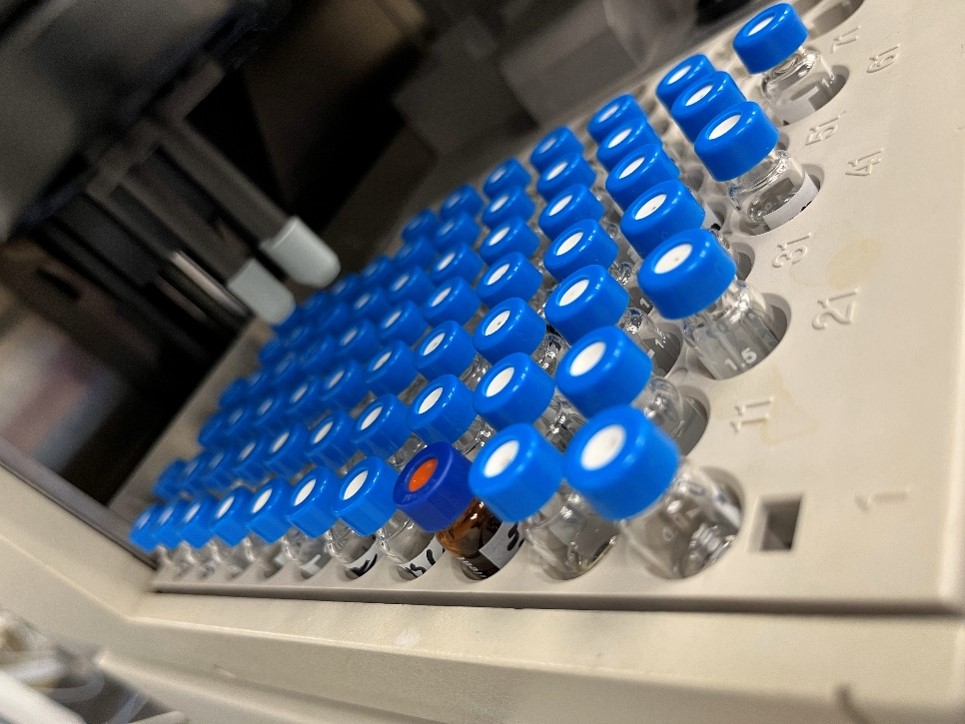Liquid Chromatography Mass Spectrometry Analysis
Liquid chromatography mass spectrometry (LC-MS) is a variant of high-performance liquid chromatography (HPLC) and is a fundamental analytical technique used to separate complex mixtures of organic compounds. The incorporation of mass spectrometry allows for the structural analysis and trace quantitation (even in highly complex matrices) of a wide range of analytes, from small molecules to polymers. The technique relies on the principles of HPLC to separate mixtures with multiple components, while mass spectrometry provides molecular identity of individual components with high specificity and detection. LC-MS is used to analyze thermally labile compounds that would be destroyed by the high heat of GC-MS.
Typical Analysis Examples
- Drug delivery elution kinetics
- Trace compound determination in a biologically derived matrix
- Repeat unit analysis for polymer identification
- Oligomeric identification and quantitation
LC-MS Applications
- Structural analysis and molecular weight determination of polymers and oligomers
- Polymer additive analysis
- Analysis of polymer degradation products
- Deformulation of polymer-based compositions
- Chemical residue analysis – root cause analysis of contamination
- Drug release profiles from drug/medical device combination products
- API purity and stability assessment
- Residual monomer analysis
- Excipient characterization
- Lot comparison, resin equivalency, good/bad comparison
- Trace impurity/contaminant characterization
- Extractables and leachables
- Cleaning validation
Analytical Techniques
LC-MS-MS (Liquid Chromatography Tandem Mass Spectrometry)
Overview:
LC-MS-MS, also known as tandem mass spectrometry, is an advanced analytical technique that combines the separation capabilities of liquid chromatography with the high sensitivity and specificity of two mass spectrometers arranged in series. After chromatographic separation, analytes are ionized and passed through the first mass analyzer, which selects ions of a specific mass-to-charge ratio (precursor ions). These ions are then fragmented in a collision cell, and the resulting product ions are analyzed by a second mass analyzer. This process allows for highly selective and sensitive detection of compounds, even in complex matrices.
Key Advantages:
- High resolution and mass accuracy for compound identification and characterization
- Exceptional sensitivity and specificity for trace-level quantitation
- Ability to analyze multiple analytes simultaneously (multiplexing)
- Minimal sample preparation for many applications
- Gold standard for biomolecular analysis, drug development, biomarker discovery, and clinical diagnostics
Typical Applications:
- Quantitative analysis of pharmaceuticals
- Non-targeted screening and identification of unknowns in complex matrices
- Degradation product identification and quantification
LC-UV (Liquid Chromatography with Ultraviolet Detection)
Overview:
LC-UV, or HPLC-UV, utilizes ultraviolet (UV) absorption as the detection method following chromatographic separation. As analytes elute from the LC column, they pass through a flow cell where their absorption of UV light at specific wavelengths is measured. The degree of absorption is directly proportional to the concentration of the analyte, allowing for quantitative analysis.
Key Advantages:
- Simple, robust, and cost-effective detection method
- Widely used for compounds with chromophores that absorb in the UV-visible range
- Non-destructive, enabling further analysis if needed
- Suitable for routine quality control and quantitation in pharmaceuticals, food, and environmental testing
Limitations:
- Only detects compounds that absorb UV light; non-chromophoric compounds are not detected
- Lower specificity compared to mass spectrometry—co-eluting compounds with similar UV spectra can be difficult to distinguish
- Typically, higher detection limits compared to mass spectrometry
Typical Applications:
- Quantitative analysis of drugs, peptides, and proteins with UV-absorbing groups
- Purity assessment and impurity profiling
- Routine quality control in pharmaceutical and chemical industries
LC-TOF (Liquid Chromatography Time-of-Flight Mass Spectrometry)
Overview:
LC-TOF couples liquid chromatography with time-of-flight mass spectrometry, a high-resolution technique that accelerates ions through an electric field and measures the time each ion takes to reach the detector. This time is proportional to the mass-to-charge ratio, enabling accurate mass measurement and molecular profiling.
Key Advantages:
- High mass accuracy and resolution, enabling identification and characterization of isobaric compounds
- Capable of both qualitative and quantitative analysis
Limitations:
- Generally lower sensitivity and narrower dynamic range compared to tandem MS (LC-MS-MS)
- Reduced mass accuracy and resolution compared to LC-MS-MS
Typical Applications:
- Screening for contaminants in food safety
- Identification and quantification of drugs and related impurities
- Characterization of biomolecules
Summary Table: Comparison of LC-MS-MS, LC-UV, and LC-TOF
| Technique | Key Strengths | Typical Applications | Limitations |
|---|---|---|---|
| LC-TOF | High sensitivity & specificity for qualitative and quantitative analysis | Targeted contaminant screening Drug quantitation | Reduced mass accuracy and resolution compared to LC-MS-MS |
| LC-UV | Simplicity, robustness, cost-effective | Routine QC, quantitation of UV-absorbing drugs/peptides/proteins | Only detects UV-absorbing compounds, lower specificity |
| LC-MS-MS | High resolution, accurate mass, untargeted screening, broad compound coverage | Unknown/novel contaminant screening in complex mixtures | Complex data interpretation, higher cost |
Choosing the Right Technique
The selection between LC-MS-MS, LC-UV, and LC-TOF depends on the analytical requirements:
- For routine quantitation of known, UV-absorbing compounds, LC-UV is often sufficient.
- For high-sensitivity, targeted quantitation, LC-TOF is preferred.
- For high-resolution, untargeted screening and identification of unknowns, LC-MS-MS is ideal.
These complementary techniques ensure comprehensive analytical coverage for a wide range of research and quality control needs in pharmaceuticals, environmental science, and beyond.


